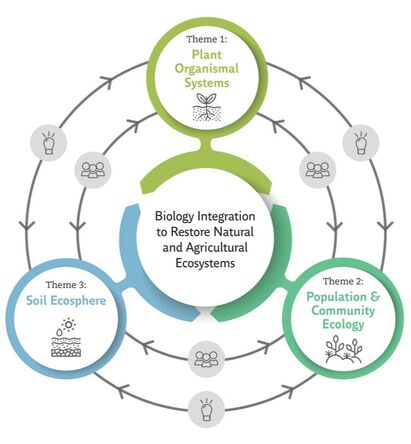Institute Overview
What components of natural ecosystems, like the North American Prairie shown above, have allowed it to sustain itself for thousands of years? The prairie comprises long-lived (perennial) plants growing together in diverse assemblages that build soil and the soil microbial community.
Through their root systems, plants connect aboveground components of terrestrial ecosystems to the soil, yet we lack a basic understanding of how plant traits, from roots to shoots, govern these connections.
|
Our work can be divided into two broad questions: What are the genetic and environmental forces that determine perennial plant phenotypes? And what are the influences of perennial plant phenotypes on community and ecosystem properties?
|
Plant Organismal Systems
Plants are unusual organisms: Half the plant body (primarily the shoot system) is surrounded by air, while the other half of the plant body (primarily the root system) is surrounded by soil. Because plants support productivity in natural and agricultural ecosystems and build soils through their roots, understanding variation and covariation in above- and belowground traits is critical.
|
Population and Community Ecology
We will test the distribution of traits among populations within species and the plasticity of traits across environments. We will test the extent to which plant traits determine community and soil ecosphere properties. Specifically, we will answer basic questions including: why are plant communities so diverse, why are diverse communities more productive and what determines the rates of carbon sequestration in soil?
|
Soil Ecosphere
A primary goal of the Institute is to understand the reciprocal influences of the soil ecosphere on root and shoot phenotypes, and vice versa. Ecosphere includes (1) interactions between plant species, (2) interactions between plants and soil organisms, and (3) mutual influences between plants and soil physicochemical properties and structure. We hypothesize changes in all three will occur as plant communities undergo restoration and will help define restoration as it applies to plant-soil interactions.
|
Working in natural and agricultural systems in tandemLand-use conversion, including both urbanization and agriculture based on annual plant monocultures, has impacted 75% of lands globally, and has contributed to the loss of ~50% of the world’s topsoil in the last 150 years.
|
Revolutionizing how we train the next generation of scientists
Recognizing that restoration requires a diverse, nimble workforce that spans disciplines, the Institute establishes education, training, diversifying, and outreach intentionally designed with many points of entry and ready mobility across labs and institutions.
|
Diversify
A vibrant and diverse STEM pipeline is critical to the nation’s economy, innovation capability, and economic prosperity. In an effort to address this need, there is a nation-wide call to action regarding increasing PEER scientists through early engagement in STEM research. Creating an inclusive culture for diversity, which includes respecting and appreciating the intellectual and humanistic qualities of PEER Institute members, moves beyond equitable practices and is essential to supporting their success.
|
Educate
Partner institutions will support trainees at the high school, undergraduate (REU), graduate, and postdoctoral levels. Trainees will be vertically integrated within the Institute, working as part of local teams on specific projects (see Research Activities). In addition, trainees will engage with the broader Institute through regular in-person and virtual Institute-wide activities. We will actively promote student advancement and cross-institution activities that assist trainees in moving from their first Institute training experience to a second one in another Institute organization. |
Train
Quality mentorship and leadership skills are more important now than ever before as we simultaneously grow collaborations between researchers, institutions, and disciplines while endeavoring to break down the barriers in science that prevent PEER students from becoming practicing scientists [128]. We are developing leadership and mentorship training program that includes all levels of trainees, from high school students (see Outreach Activities) through postdocs.
|
A compelling biological question poised for breakthroughs
What components of natural ecosystems, like the North American Prairie shown above, have allowed it to sustain itself for thousands of years?
We believe part of the answer to improving restoration success lies underground, in the understanding of how root traits influence plant interactions with each other - and with the soil ecosphere. Our work will provide insights into species coexistence and community assembly, which are directly applicable to ecological restoration. |








